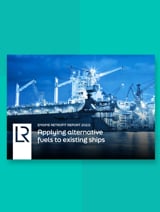LR’s Product Manager for Classification and Technology, Peter Catchpole, reviews the current state of the container ship market.
Over the last few years carriers have increased capacity at a greater rate than market demand, and it seems likely that this will continue as ULCS feature prominently in the orderbooks. The overcapacity puts pressure on freight rates and hence drives carriers to focus on cost cutting and operational efficiencies. It is no co-incidence we have seen consolidation in the market over the last few years with the acquisitions of OOCL, UASC and Hamburg Sud, as well as the joint venture between K Line, MOL and NYK to form ONE. It is hard to imagine a new entrant coming into the market any time soon.
The carriers are looking to improve operational efficiencies in other ways too. Container shipping has seen the establishment TradeLens, a block chain solution that allows the various stakeholders to co-operate on populating, updating, analysing and reporting on data associated with the shipment of containers. This is intended to replace expensive manual and peer to peer solutions. While it is not clear how many containers are currently being processed on the network, the fact that Maersk, MSC, CMA CGM, Hapag Lloyd and ONE have all joined (along with a large number of other supply chain stakeholders) suggest that TradeLens may be around for some time to come.
Given the current overcapacity it is surprising that, excluding feeder ships, the total capacity of the container ships sent for demolition in the year to date is less than 75,000 teu; compared with deliveries for the year to date totalling 516,499 teu (according to IHS database September 2019). Part of the reason is that the carriers, within the framework of the mega shipping alliances, have become very agile in managing capacity, designing their routes and schedules so that if demand on a specific route reduces temporarily then capacity can also be reduced by blanking sailings. The repurposing of older container ships as large feeder container ships has also played a part.
When it comes to the capacity of individual ships we have seen the record for the largest container ship broken several times a year for quite a few years now. Evergreen recently agreed an US$920million deal with Samsung Heavy Industries to build six large container ships – surpassing the world’s largest container ships with a capacity of 23,756 teu. However as overall ship size hasn’t increased, this has been achieved through the ingenuity of designers and maybe also due to changes to classification rules for container securing. For instance, LR’s cutting edge rules provide a fully non-linear assessment of each container stack to account for the increased loading of lashing rods when twist lock separation occurs; but the calculations are still fast enough to support planning teams when developing stowage plans for 23,000teu vessels.
Maybe the more interesting question is whether we will see ULCS designs with 26 rows across, certainly this is technically possible, and there would be increased operational efficiency (CO2/teu/km and $/teu/km) however the challenge is likely to be shore side infrastructure – the current vessels are approaching the maximum size that ports can handle. Larger ships also present greater commercial risk as the value of the cargo on a 22,00 teu container ship can be worth more than $2 billion, so if an incident occurs the consequences are much greater.





